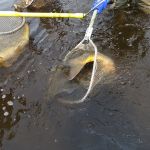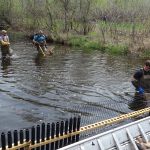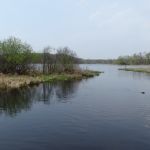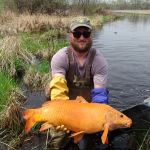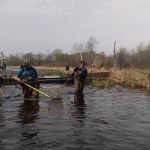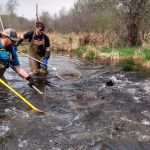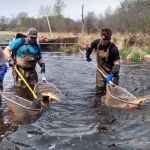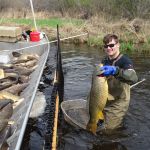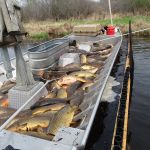Pleasant Lake Carp Removal
A common carp population lives in the chain of lakes from Charley to East Vadnais Lake. Originally from Europe, these fish were introduced to the United States from Germany in 1877 and, over the next several decades, were distributed through government programs as a food source. Now, over 150 years later, common carp, as well as other types of non-native carp, have become established and invasive in waterbodies across the continent. Many states and organizations seek to remove them in the interest of balancing aquatic ecosystems and improving water quality.
Why remove the carp?
As bottom-feeders, common carp continually stir up lake sediments. This dislodges aquatic vegetation and stirs nutrients into the water column. The resulting exposed lakebed is less resilient, and this can tip the lake into a murky, turbid state. A turbid lake is a poor home for native fish and plants, and is very difficult to tip back to a balanced, clean water state.
Planning for a harvest:
Carp occupy lakes including Charley, Deep, Pleasant, Sucker, and East Vadnais Lakes. VLAWMO staff started monitoring and tracking common carp in Pleasant Lake in 2019 because many carp spend the summer and winter months in Pleasant. These fish travel out of Pleasant Lake, through Deep Lake, as they try to reach their spawning area in Wilkinson Lake. They are not able to reach Wilkinson Lake because a highly effective barrier was installed in 1994 by North Oaks Company at Wilkinson Lake to prevent carp entry.
Pleasant Lake is also listed as impaired for excessive nutrient levels, which VLAWMO strives to remedy with this carp removal and other best management practices in and around the lake.
Monitoring efforts allowed staff and project partners to calculate the carp biomass, understand their movement patterns, and predict how to remove enough carp to reach the management threshold for water-quality improvement. The management threshold for common carp is 100 kg/ha, and is the level demonstrated by past carp removals to be the point where we would expect to see measurable improvements in water quality. The biomass estimate for Pleasant Lake prior to the removal effort was 273 kg/ha, nearly 3 times the management threshold. Under-ice seine netting was attempted during the winter of 2021/2022, but aggregated carp dispersed when a harvest was attempted and did not gather again in a single location following that attempt.
Complete eradication of common carp is highly unlikely and not a practical goal. The results of this effort strive for reduced population levels that allow for improved water quality.
A barrier system was set-up in April 2022. When carp started traveling upstream to spawn, they became trapped between two barriers. Their movement and arrival were detected by using implanted active and passive tags. Active tags can be sensed from a longer distance and give a heads-up that the fish are coming. Passive tags are sensed by an antenna when the carp are close by. To be doubly sure nothing was missed, a remote camera transmitting photos real time was also mounted at the barrier. When the carp gathered at the upstream barrier, it was go time for removal.
The harvest marks a new opportunity for these lakes and an exciting step towards a healthier watershed!
What happens to the carp?
The carp are immediately euthanized with a natural fish anesthetic. They are applied as fertilizer to farmland in Northern Minnesota. Carp Solutions is not licensed as a commercial fishing operation.
Project partners:
VLAWMO thanks its many partners that have allowed this effort to be a success:
- Carp Solutions
- St Paul Regional Water Services
- North Oaks Company
- North Oaks Home Owners’ Association
- WSB, Inc.
More information:
Visit the Pleasant Lake Carp Removal project page
Carp management in the news: Rice Creek Watershed District


